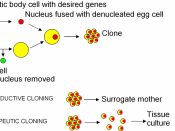One of the most famous advancements in Genetic issues occurred when "Dolly" the sheep was born on February 24, 1997, in Edinburgh Scotland. She was cloned from a cell of another sheep. Prior to her birth scientists thought mammals could not be successfully cloned or that they could even survive. On April 23, 1998, Dolly gave birth to a daughter named, "Bonnie". This birth proved that Dolly was not just a successful living clone when she was first born, but that she succeeded in growing and maturing to the adult stage.
There are many debates whether cloning should be allowed in humans or even in animals. Some issues on human cloning has been brought to the light of controversy with the reproduction method that it can or will cause sports teams to use cloned superstars. Others suggest cloning will eliminate disease and hereditary disorders from Earth's species.
The word cloning simply refers to making identical copies of something from one unit.
Although the word may produce an image of mad scientists making copies of humans, the reality of it is that cloning is currently only being used for medical benefits, and very few scientists have expressed the desire to clone humans.
There are three main types of cloning that scientist's use: embryo cloning, reproductive cloning and therapeutic cloning. Embryo cloning is basically a medical technique, which duplicates the process that nature uses to produce twins or triplets. Reproductive cloning involves producing a duplicate of an existing animal. Finally, therapeutic cloning is a procedure that starts off like adult DNA cloning.
The company that helped to create Dolly has reported an early step in the possibility use of cloning to treat human disease. This group created genetically engineered cloned pigs. Pigs are potentially good sources of organs for human transplantation needs...


